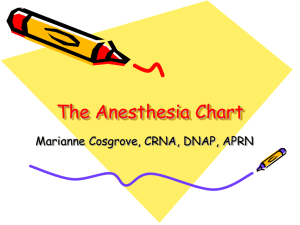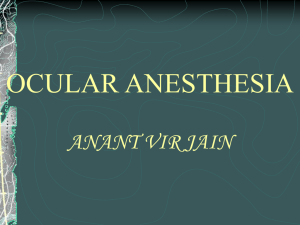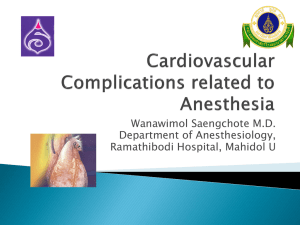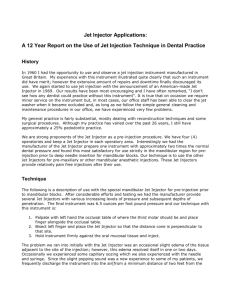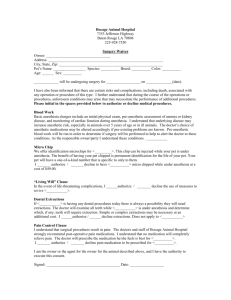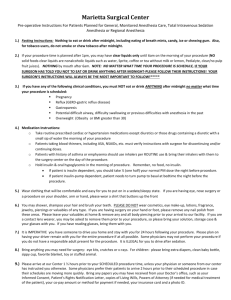In-Office Anesthesia Without Use of Needles
advertisement
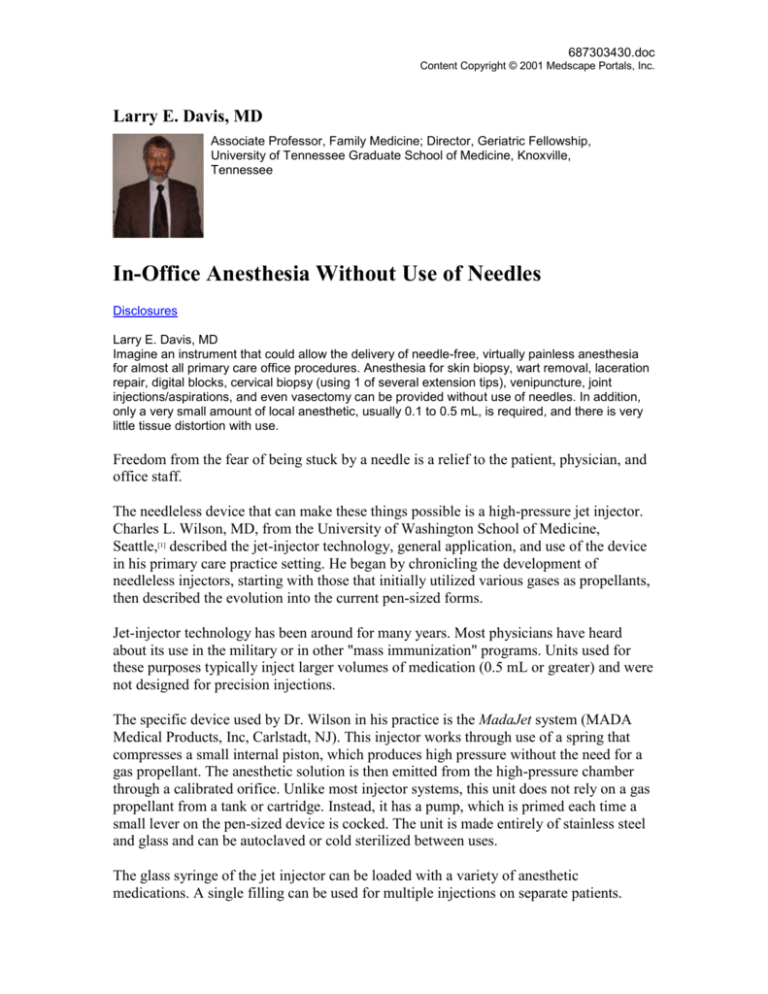
687303430.doc Content Copyright © 2001 Medscape Portals, Inc. Larry E. Davis, MD Associate Professor, Family Medicine; Director, Geriatric Fellowship, University of Tennessee Graduate School of Medicine, Knoxville, Tennessee In-Office Anesthesia Without Use of Needles Disclosures Larry E. Davis, MD Imagine an instrument that could allow the delivery of needle-free, virtually painless anesthesia for almost all primary care office procedures. Anesthesia for skin biopsy, wart removal, laceration repair, digital blocks, cervical biopsy (using 1 of several extension tips), venipuncture, joint injections/aspirations, and even vasectomy can be provided without use of needles. In addition, only a very small amount of local anesthetic, usually 0.1 to 0.5 mL, is required, and there is very little tissue distortion with use. Freedom from the fear of being stuck by a needle is a relief to the patient, physician, and office staff. The needleless device that can make these things possible is a high-pressure jet injector. Charles L. Wilson, MD, from the University of Washington School of Medicine, Seattle,[1] described the jet-injector technology, general application, and use of the device in his primary care practice setting. He began by chronicling the development of needleless injectors, starting with those that initially utilized various gases as propellants, then described the evolution into the current pen-sized forms. Jet-injector technology has been around for many years. Most physicians have heard about its use in the military or in other "mass immunization" programs. Units used for these purposes typically inject larger volumes of medication (0.5 mL or greater) and were not designed for precision injections. The specific device used by Dr. Wilson in his practice is the MadaJet system (MADA Medical Products, Inc, Carlstadt, NJ). This injector works through use of a spring that compresses a small internal piston, which produces high pressure without the need for a gas propellant. The anesthetic solution is then emitted from the high-pressure chamber through a calibrated orifice. Unlike most injector systems, this unit does not rely on a gas propellant from a tank or cartridge. Instead, it has a pump, which is primed each time a small lever on the pen-sized device is cocked. The unit is made entirely of stainless steel and glass and can be autoclaved or cold sterilized between uses. The glass syringe of the jet injector can be loaded with a variety of anesthetic medications. A single filling can be used for multiple injections on separate patients. 687303430.doc Content Copyright © 2001 Medscape Portals, Inc. Because no part of the device penetrates the patient, it is only necessary to change the disposable tip that touches the patient before using again. However, cold sterilization between patients is recommended. The evolution of the jet device has allowed increased reliability and portability, more economical operation, and better patient acceptance due to the less intimidating visual appearance of the device. It is also virtually silent when delivering a dose of local anesthetic. Fears that such devices might spread infection by tiny amounts of "splash back" of blood created with each discharge of the injector have been alleviated through the use of disposable tips and by cold sterilization between patients, similar to the sterilization of a colonoscope. As mentioned earlier, there is no chance that the physician or office staff can suffer a needlestick that is contaminated by a patient's blood with use of the jet device. The cost per injection is estimated to be about $0.13 with the jet injector, compared with about $0.90 using a syringe, needle, and larger volume of anesthetic solution. There may be an additional cost associated with traditional needle anesthesia if some of the anesthetic solution is wasted, as it typically is in most clinical situations. Overall, the volume of medical waste associated with the use of this device is also greatly reduced, compared with the more familiar syringe-and-needle system used in most family physician's offices. The anesthesia produced by the jet injector is rapid and more precise than that of the standard syringe-and-needle system. It also affords patients who fear needles an alternative when local anesthesia is indicated. The injector jet is held perpendicular to the skin surface and firm pressure is applied. Then the release button is pushed to disperse the anesthetic. The patient typically hears a popping sound as the anesthetic is delivered. They usually report a sensation described similar to that of a rubber band being snapped against the skin. The injection is instantaneous, so the device may be removed or repositioned immediately for another injection. The injection stream penetrates about 4 mm into tissue, and disperses to about 1.0 to 1.5 cm in diameter. The skin surface may blanche and a pinpoint entry site may be visible. Penetration may cause a tiny drop of blood to appear. The injection-site entry point will be roughly equivalent in size to the puncture made by a 26-30 gauge needle. Multiple injections can be used to anesthetize larger areas if needed. As with standard injection methods, care must be taken not to injure adjacent tissues, such as nerves, bones, and blood vessels. Any standard anesthetic solutions may be used in the device. Dr. Wilson described his use of a jet injector when performing no-scalpel vasectomy. He has done over 1000 of these procedures to date. He is able to use only 2 injections of 0.1 687303430.doc Content Copyright © 2001 Medscape Portals, Inc. mL 2% lidocaine in 90% of patients, without supplemental infiltration of local anesthesia. In the usual vas deferens anesthesia technique, up to 6 mL of local anesthetic is infiltrated into the scrotum. Use of the injector not only greatly reduces the volume of anesthetic used, but also prevents the small risk of cord hematoma that can occur when a needle is used to administer the traditional block. Most primary care doctors perform procedures daily that need local anesthesia that is safe, effective, and as pain-free as possible. Ethyl chloride spray, ice cubes, and EMLA (lidocaine 2.5% and prilocaine 2.5%) cream and anesthetic discs all have significant limitations in meeting these objectives in office practice. A review of the literature revealed a marked scarcity of research comparing local anesthesia delivered by needle vs a jet-injector system. The few studies conducted over the past 20 years showed a mixed pattern of patient satisfaction. However, the majority of recent research has demonstrated less painful injection when a jet device was compared with traditional needle delivery. Studies demonstrating superior results included comparison with a 25-gauge needle for delivery of anesthesia prior to large-bore intravenous (IV) cannula insertion[2,3] and for delivery of anesthesia prior to pediatric dental operative procedures.[4] Another study comparing subcutaneous administration of midazolam showed less discomfort with the jet injector, but the results were not statistically significant.[5] However, patient reports of persistent discomfort at site of needle injection were significantly greater. Jet injection was also shown to be less painful immediately and at 12 hours postprocedure for patients undergoing digital blocks; adequate anesthesia was obtained in 23 of 24 patients.[6] Although jet injection technology has been used by dentists for many years to provide intra-oral anesthesia, and by some podiatrists, the growth rate of use by primary care physicians has been low up to this point. Most primary care physicians remain unaware of the potential usefulness of this device in an office setting. This may be due in part to the lack of effective marketing. Use of these devices in training programs may have given dentists and podiatrists the opportunity to gain experience with the technology under faculty supervision. Providing similar exposure to the injectors in the medical residency training setting could provide the opportunity needed for primary care physicians in training to gain such experience. Seminars at medical meetings could also provide opportunity for learning about the devices, but unfortunately only a limited chance to gain experience under the guidance of an experienced instructor. Initial purchase price may also be a contributing factor to the relatively low percentage of primary care physicians using these devices. The injector device costs between $600$800 per unit. But with a savings of $0.75 per use, the device may "pay for itself" within a few years of use in a busy practice. The increased safety of staff and the higher patient acceptance of needed minor procedures are also important considerations in determining 687303430.doc Content Copyright © 2001 Medscape Portals, Inc. whether to purchase an injector device. Word of mouth could also produce increased referrals when satisfied patients share their experiences with others. In review, some of the procedures that can be performed with needleless anesthesia include: Joint and bursa injection/aspiration Skin lesion excision, biopsy, cryosurgery, curettage Excision of ingrown nails (digital blocks) Laceration repair Incision and drainage of abscesses; cyst excision Cervical biopsy Vasectomy Lumbar puncture Blood drawing and IV access Advantages of jet-injection anesthesia include: No chance of needle-stick injury Decreased fear of procedures Decreased volume of local anesthetic used More precise local anesthesia Less tissue distortion Less expensive local anesthesia Disadvantages of jet injection anesthesia include: Initial cost of device Most PCP's not familiar with its use Hopefully, this technology will soon claim a place in the primary care office setting. References 1. Wilson, CL. No-needle anesthesia. Program and abstracts from the American Academy of Family Physicians 2001 Scientific Assembly; October 3-7, 2001; Atlanta, Georgia. Session 266. 2. Cooper JA, Bromley LM, Baranowski AP, Barker SG. Evaluation of a needle-free injection system for local anaesthesia prior to venous cannulation. Anesthesia. 2000;55:247-250. 3. Zsigmond EK, Darby P, Koenig HM, Goll EF. Painless intravenous catheterization by intradermal jet injection of lidocaine: a randomized trial. J Clin Anesth. 1999;11:87-94. 4. Munshi AK, Hegde A, Bashir N. Clinical evaluation of the efficacy of anesthesia and patient preference using the needle-less jet syringe in a pediatric dental practice. J Clin Pediatr Dent. 2001;25:131-136. 5. Bennett J, Nichols F, Rosenblum M, Condry J. Subcutaneous administration of medazolam: a comparison of the Bioject jet injector with the convential syringe and needle. J Oral Maxillofac Surg. 1998;56:1249-1254. 6. Ellis Gl, Owens A. The efficacy and acceptability of using a jet injector in performing digital blocks. Am J Emerg Med. 1993;11:648-650.
